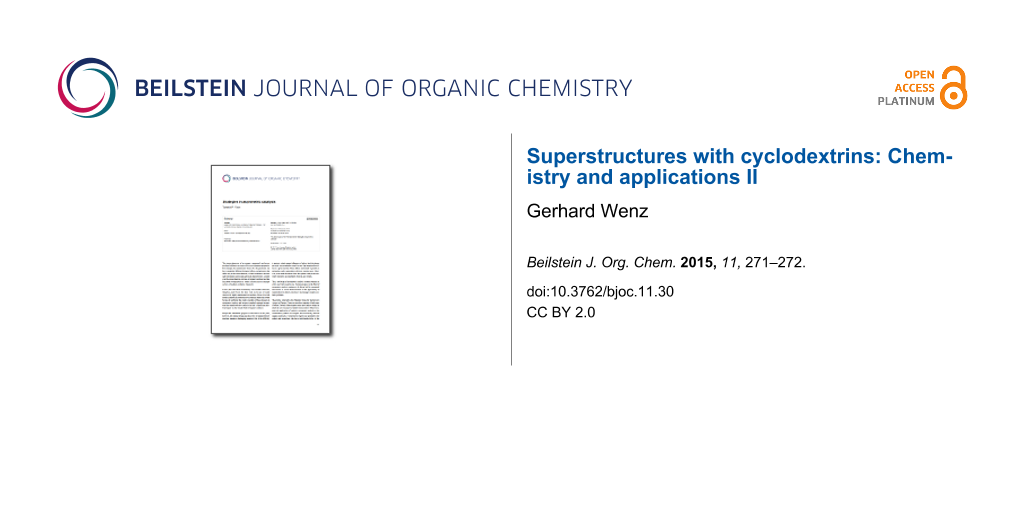Cyclodextrins (CDs) are cyclic α(1→4)-linked oligomeres of anhydroglucose. Since the 6-, 7- and 8-membered rings, called α-, β- and γ-CD, respectively, can be produced through the enzymatic degradation of starch on an industrial scale with high purity [1], CDs are now considered to be the most interesting class of organic host molecules. Furthermore, α- and γ-CDs are known to be nontoxic and are approved as food additives [2,3]. Since CDs are soluble in water and able to solubilize hydrophobic active ingredients, they are broadly used in biomedical applications [4]. CDs are also well known to complex suitable monomeric and polymeric guest molecules, leading to supramolecular structures and topological compounds, such as rotaxanes and polyrotaxanes [5-7]. The solubility and stability of CD complexes are controllable through the derivatization of CDs. Remarkable progress has been achieved over the past 10 years regarding the regioselective derivatization of cyclodextrins. Synthetic procedures for CD key derivatives such as mono-6-O-tosyl-β-CD were optimized to allow for production on a large scale [8]. More than one and up to 6 different substituents have been attached at various defined locations on the CD ring [9,10]. Some CD derivatives have already found very interesting applications in the design of aqueous-phase catalysts [11]. Many other applications are certain to follow.
The 17th International Cyclodextrin Symposium, held in May 2014 in Saarbrücken, Germany provided an overview of the various aspects of CD chemistry, such as organic synthesis, analysis of inclusion compounds, polymeric and colloidal systems, as well as smart materials and drug delivery. These contributions to Cyclodextrin Chemistry are collected in this Thematic Series of the Beilstein Journal of Organic Chemistry.
Gerhard Wenz
Saarbrücken, January 2015
References
-
Schallmey, M.; Singh, A.; Ward, O. P. Can. J. Microbiol. 2004, 50, 1–17. doi:10.1139/w03-076
Return to citation in text: [1] -
2008/413/EC: Commission Decision of 26 May 2008 authorising the placing on the market of alpha-cyclodextrin as a novel food ingredient under Regulation (EC) No 258/97 of the European Parliament and of the Council (notified under document number C(2008) 1954; Official Journal of the European Union, 2008. 51,12 (http://eur-lex.europa.eu/legal-content/EN/TXT/?uri=uriserv:OJ.L_.2008.146.01.0012.01.ENG).
Return to citation in text: [1] -
2012/288/EU: Commission Implementing Decision of 1 June 2012 authorising the placing on the market of Gamma-Cyclodextrin as a novel food ingredient under Regulation (EC) No 258/97 of the European Parliament and of the Council (notified under document C(2012) 3496; Official Journal of the European Union, 2012, 55, 41. (http://eur-lex.europa.eu/legal-content/EN/TXT/?uri=uriserv:OJ.L_.2012.144.01.0041.01.ENG).
Return to citation in text: [1] -
Brewster, M. E.; Loftsson, T. Adv. Drug Delivery Rev. 2007, 59, 645–666. doi:10.1016/j.addr.2007.05.012
Return to citation in text: [1] -
Wenz, G. Angew. Chem., Int. Ed. Engl. 1994, 33, 803–822. doi:10.1002/anie.199408031
Return to citation in text: [1] -
Wang, W.; Kaifer, A. E. Cucurbituril and Cyclodextrin Complexes of Dendrimers. In Inclusion Polymers; Wenz, G., Ed.; Advances in Polymer Science, Vol. 222; Springer-Verlag: Berlin, 2009; pp 1–54. doi:10.1007/12_2008_1
Return to citation in text: [1] -
Harada, A.; Hashidzume, A.; Yamaguchi, H.; Takashima, Y. Chem. Rev. 2009, 109, 5974–6023. doi:10.1021/cr9000622
Return to citation in text: [1] -
Popr, M.; Hybelbauerová, S.; Jindřich, J. Beilstein J. Org. Chem. 2014, 10, 1390–1396. doi:10.3762/bjoc.10.142
Return to citation in text: [1] -
Guieu, S.; Sollogoub, M. Advances in Cyclodextrin Chemistry. In Modern Synthetic Methods in Carbohydrate Chemistry; Werz, D. B.; Vidal, S., Eds.; Wiley-VCH: Weinheim, Germany, 2014; pp 241–283. doi:10.1002/9783527658947.ch9
Return to citation in text: [1] -
Wang, B.; Zaborova, E.; Guieu, S.; Petrillo, M.; Guitet, M.; Blériot, Y.; Ménand, M.; Zhang, Y.; Sollogoub, M. Nat. Commun. 2014, 5, No. 5354. doi:10.1038/ncomms6354
Return to citation in text: [1] -
Hapiot, F.; Ponchel, A.; Tilloy, S.; Monflier, E. C. R. Chim. 2011, 14, 149–166. doi:10.1016/j.crci.2010.04.003
Return to citation in text: [1]
| 1. | Schallmey, M.; Singh, A.; Ward, O. P. Can. J. Microbiol. 2004, 50, 1–17. doi:10.1139/w03-076 |
| 8. | Popr, M.; Hybelbauerová, S.; Jindřich, J. Beilstein J. Org. Chem. 2014, 10, 1390–1396. doi:10.3762/bjoc.10.142 |
| 5. | Wenz, G. Angew. Chem., Int. Ed. Engl. 1994, 33, 803–822. doi:10.1002/anie.199408031 |
| 6. | Wang, W.; Kaifer, A. E. Cucurbituril and Cyclodextrin Complexes of Dendrimers. In Inclusion Polymers; Wenz, G., Ed.; Advances in Polymer Science, Vol. 222; Springer-Verlag: Berlin, 2009; pp 1–54. doi:10.1007/12_2008_1 |
| 7. | Harada, A.; Hashidzume, A.; Yamaguchi, H.; Takashima, Y. Chem. Rev. 2009, 109, 5974–6023. doi:10.1021/cr9000622 |
| 4. | Brewster, M. E.; Loftsson, T. Adv. Drug Delivery Rev. 2007, 59, 645–666. doi:10.1016/j.addr.2007.05.012 |
| 2. | 2008/413/EC: Commission Decision of 26 May 2008 authorising the placing on the market of alpha-cyclodextrin as a novel food ingredient under Regulation (EC) No 258/97 of the European Parliament and of the Council (notified under document number C(2008) 1954; Official Journal of the European Union, 2008. 51,12 (http://eur-lex.europa.eu/legal-content/EN/TXT/?uri=uriserv:OJ.L_.2008.146.01.0012.01.ENG). |
| 3. | 2012/288/EU: Commission Implementing Decision of 1 June 2012 authorising the placing on the market of Gamma-Cyclodextrin as a novel food ingredient under Regulation (EC) No 258/97 of the European Parliament and of the Council (notified under document C(2012) 3496; Official Journal of the European Union, 2012, 55, 41. (http://eur-lex.europa.eu/legal-content/EN/TXT/?uri=uriserv:OJ.L_.2012.144.01.0041.01.ENG). |
| 11. | Hapiot, F.; Ponchel, A.; Tilloy, S.; Monflier, E. C. R. Chim. 2011, 14, 149–166. doi:10.1016/j.crci.2010.04.003 |
| 9. | Guieu, S.; Sollogoub, M. Advances in Cyclodextrin Chemistry. In Modern Synthetic Methods in Carbohydrate Chemistry; Werz, D. B.; Vidal, S., Eds.; Wiley-VCH: Weinheim, Germany, 2014; pp 241–283. doi:10.1002/9783527658947.ch9 |
| 10. | Wang, B.; Zaborova, E.; Guieu, S.; Petrillo, M.; Guitet, M.; Blériot, Y.; Ménand, M.; Zhang, Y.; Sollogoub, M. Nat. Commun. 2014, 5, No. 5354. doi:10.1038/ncomms6354 |
© 2015 Wenz; licensee Beilstein-Institut.
This is an Open Access article under the terms of the Creative Commons Attribution License (http://creativecommons.org/licenses/by/2.0), which permits unrestricted use, distribution, and reproduction in any medium, provided the original work is properly cited.
The license is subject to the Beilstein Journal of Organic Chemistry terms and conditions: (http://www.beilstein-journals.org/bjoc)








